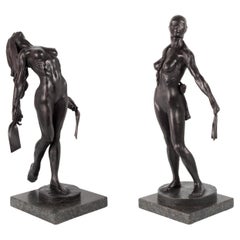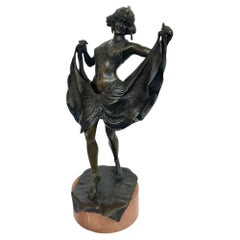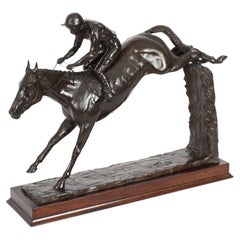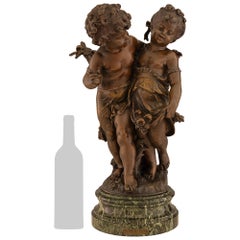Bronze Figurative Sculptures
to
763
4,211
171
127
88
1,715
2,408
298
917
554
470
128
57
216
119
60
79
73
86
105
79
583
259
244
195
178
92
70
48
31
27
17
17
12
7
6
5
1
1
7,253
4,509
3,898
3,532
2,872
2,126
1,973
3,197
1,807
486
411
351
Height
to
Width
to
4,509
4,385
4,425
47
28
27
26
24
Material: Bronze
Powerful Hermanas: Elizabeth and Irene, Female Nude Bronze Pair by Dean Kugler
Located in Chicago, IL
The nude from Ancient Roman art is a conceptually perfected ideal person, each one a vision of health, youth, geometric clarity, and organic equilibrium. Kugler considers an emphasis...
Category
2010s American Greco Roman Bronze Figurative Sculptures
Materials
Bronze
"Windy Day" Vienna Bronze Sculpture by Franz Xaver Bergmann, c. 1900
Located in Los Angeles, CA
Rare Vienna bronze sculpture by Franz Xaver Bergmann with excellent detail throughout depicting a young exotic dancer swirling her skirt hinged to lift and reveal her naked body stan...
Category
Early 1900s Austrian Antique Bronze Figurative Sculptures
Materials
Stone, Bronze
Large Patinated Bronze Figure of "Docklands Express" by Philip Blacker Date 1993
Located in London, GB
A large fine patinated bronze sculpture titled "Docklands Express" by Philip Blacker (1949- British), dated 1993.
The sculpture features a horse call...
Category
1990s British Bronze Figurative Sculptures
Materials
Bronze
Baroque Bronze Mermaid Door Knocker Mounted on Lucite Stand, German 1680-1700
Located in Haddonfield, NJ
Early German baroque bronze mermaid door knocker on frosted lucite stand.
This door knocker is a work of art; heavy bronze with original patina, ...
Category
Early 1700s German Baroque Antique Bronze Figurative Sculptures
Materials
Bronze
$880 Sale Price
74% Off
Maitreya Future Buddha Gilt Bronze Tibetan Statue
Located in Somis, CA
A special statue of the Tibetan Bodhisattva Maitreya, the Future Buddha. Depicted sitting on a high lotus throne, wearing a large decorated crown before a flame-shaped mandola and pair of flower posts, long earrings that touch the shoulders and ornate necklace...
Category
20th Century Tibetan Bronze Figurative Sculptures
Materials
Bronze
French 19th Century Patinated Bronze Entitled ‘Chemin Des Roses’ by August Morea
Located in West Palm Beach, FL
A charming French 19th century patinated bronze entitled 'Chemin des Roses', Path Of the Roses, by August Moreau. The bronze is raised by a mottled circular Verde Antico marble base ...
Category
19th Century French Antique Bronze Figurative Sculptures
Materials
Marble, Bronze
René André Varnier, Demosthenes Bust, France, 1930s
By R. Varnier
Located in PARIS, FR
Superb Demosthenes bust in green hued patinated bronze by the artist René André Varnier. Excellent capture of the oratory prowess of Demosthenes considered...
Category
1930s French Art Deco Vintage Bronze Figurative Sculptures
Materials
Bronze
Carrier-Belleuse Bronze Bust of Female
Located in New York, NY
Finely cast, patinated bronze bust of a woman with butterfly on her shoulder after the original model by Albert-Ernest Carrier-Belleuse (French, 1824-1887) mounted on rouge marble ba...
Category
Late 19th Century French Antique Bronze Figurative Sculptures
Materials
Marble, Bronze
Franz Peleschka Art deco bronze
Located in Buenos Aires, Argentina
Franz Peleschka bronze sculpture
Origin Austria Circa 1900
The condition of the bronzes is excellent, its base has been restored by a professional.
Patina raised
It is signed on its ...
Category
Early 1900s Austrian Art Nouveau Antique Bronze Figurative Sculptures
Materials
Marble, Bronze
"Le Secret" Art Nouveau Bronze Sculpture by Pierre Felix Masseau
Located in Chicago, US
Fix-Masseau set up his workshop in Paris where he attracted the admiration of Rodin. The latter was unable to convince him to join his studio. The quality of his sculptures was notic...
Category
1890s French Art Nouveau Antique Bronze Figurative Sculptures
Materials
Bronze
Large Signed Bronze Sculpture of a Little Girl by Sergio Unia
Located in Redding, CT
Large Signed Bronze Sculpture of a Little Girl. By Sculptor Serigo Unia. Heavy, solid piece. Brutalist in style. Animated and cartoonish in style. Reminiscent of a character from Cha...
Category
Mid-20th Century Brutalist Bronze Figurative Sculptures
Materials
Bronze
Classical Bronze Male Nude Torso Sculpture/Statue
Located in Los Angeles, CA
Solid bronze male nudist statue. Classical Greek style sculpture.
Unsigned.
Would make a wonderful sculpture for desk, office, shelf, etc.
Category
19th Century Antique Bronze Figurative Sculptures
Materials
Bronze
$1,350 Sale Price
25% Off
Max Le Verrier Large Art Deco Bronze Vide Poche or Decorative Dish
Located in Miami, FL
Bronze vide poche or decorative dish sculpted and cast by Max Le Verrier, this example has an intentional "antiqued" appearance, inspired by ancient Greek coinage. Beautiful green an...
Category
20th Century French Art Deco Bronze Figurative Sculptures
Materials
Bronze
Art Deco Silver Plated Diana the Huntress Figure circa 1930s
Located in Dereham, GB
Art Deco Silver Plated Diana the Huntress Figure circa 1930s
Silver plated on Bronze,
Sylized Bronze figure of a deer,
Chrome Plated Base and Stylized Backround
[ some pitting to t...
Category
1930s French Art Deco Vintage Bronze Figurative Sculptures
Materials
Bronze
$738 Sale Price
20% Off
Bronze Hindu Bird-Catcher by Auguste de Wever 'Belgian, 1836-1910'
Located in Paris, FR
Large bronze statue featuring a Hindu bird-catcher by the Belgian sculptor and medallist Auguste de Wever. He wears a ribbon and a drapery supporting a small sword. His necklace is a...
Category
Late 19th Century French Art Nouveau Antique Bronze Figurative Sculptures
Materials
Bronze
Dancing Faun Candle holder in bronze by Patrick Laroche
By Laroche
Located in Paris, FR
Dancing Faun with candle holder.
Materials: Patinated bronze Brown, signed and justified EA on the base.
Made in France by Patrick Laroche, Meilleur Ouvrier de France award in the Sc...
Category
21st Century and Contemporary French Modern Bronze Figurative Sculptures
Materials
Bronze
M Ventura, Nude Of A Woman, Signed Bronze, Late 20th Century
Located in MARSEILLE, FR
Large patinated bronze sculpture of a nude woman, seated on a wooden base
Signature M Ventura P under the foot - from the 1980s
Light patina wear - cracks on the wooden base
...
Category
Late 20th Century Italian Modern Bronze Figurative Sculptures
Materials
Bronze
Crystal Ball on a 19th Century French Bronze Cherub Stand
Located in San Francisco, CA
An exceptional Renaissance style patinated and gilt bronze cherub base made in the early to mid 19th century. The figure holding a 10 inch diameter solid crystal ball.
Beautiful qu...
Category
Mid-19th Century European Renaissance Antique Bronze Figurative Sculptures
Materials
Bronze
Art Nouveau Water Lily Vase Jugendstil Bronze in the Manner of Otto Eckman
By Otto Eckmann
Located in Miami, FL
Jugendstil ceramic vase bronze mounted is an original decorative object realized in the early 20th century.
Original ceramic vase with cream and cobalt blue glaze. All around colorf...
Category
Early 19th Century German Jugendstil Antique Bronze Figurative Sculptures
Materials
Bronze
Man and Woman Embraced Patinated Bronze Sculpture by Itzik Ben Shalom
Located in San Diego, CA
Man and woman embraced patinated bronze sculpture on a black wood base in by listed Israeli artist Itzik Ben Shalom, circa 1980s. The piece is in good vintage condition with some spo...
Category
20th Century Israeli Mid-Century Modern Bronze Figurative Sculptures
Materials
Bronze
$1,440 Sale Price
20% Off
Gaulish Chef On Horseback In Bronze, 19th Century
Located in MARSEILLE, FR
Bronze with a brown patina representing a Gallic chief on horseback, pulling a woman taken prisoner
This bronze is not signed, yet great care has been taken with the details, numero...
Category
19th Century European Napoleon III Antique Bronze Figurative Sculptures
Materials
Bronze
Pendant by Novello Finotti, Italy
Located in Brussels, BE
Pendant by Novello Finotti, Italy.
Category
1970s Vintage Bronze Figurative Sculptures
Materials
Gold, Silver, Bronze
Faun with Cymbals in Bronze Italy Late 19th Century
By Non-Standard Furniture and Lighting
Located in Milano, IT
Bronze sculpture depicting faun with cymbals on red marble base.
Category
1880s Italian Other Antique Bronze Figurative Sculptures
Materials
Bronze
Skyward Bronze Sculpture
Located in Paris, FR
Sculpture Skyward bronze all in solid
bronze in brown finish.
Category
21st Century and Contemporary Belgian Bronze Figurative Sculptures
Materials
Bronze
$4,173 / item
Vintage Bronze Signed Figurative Sculpture
Located in Augusta, GA
Figurative sculpture of a man
Made of bronze
Made in the mid 20th century
signed "JCB"
Beautiful craftsmanship
Category
Mid-20th Century Unknown Bronze Figurative Sculptures
Materials
Bronze
Georges Récipon, "Lucky", Gilt Patina Bronze Sculpture / Desk Paperweight
Located in Buenos Aires, Olivos
Georges Récipon, "Lucky", Gilt Patina Bronze Sculpture / Desk Paperweight. Signed and dated.
Beautiful bronze sculpture (gold patina) representing a naked woman nailed a horseshoe, ...
Category
1890s French Art Nouveau Antique Bronze Figurative Sculptures
Materials
Bronze
Bronze Modernist Abstract Sculpture by Grégory Anatchkov, France, 1980
Located in Antwerp, Antwerp
Abstract bronze sculpture on a black marble base by french artist Grégory Anatchkov (1941 - 1997). This sculpture shows a very appealing organic composition and is different in prese...
Category
Late 20th Century French Mid-Century Modern Bronze Figurative Sculptures
Materials
Belgian Black Marble, Bronze
"Zodiac Box, " Lidded Art Deco Bronze Casket with Zodiac Symbols by Oscar Bach
Located in Philadelphia, PA
Beautifully cast and finished with a lovely, lustrous patina, this bronze lidded box depicts all 12 of the Zodiac symbols -- four on the lid and two ...
Category
1920s American Art Deco Vintage Bronze Figurative Sculptures
Materials
Bronze
$1,200 Sale Price
20% Off
Pair Of Vintage Putti Figures, French, Bronze, Marble, Cupid Ornament, Art Deco
Located in Hele, Devon, GB
This is a pair of vintage putti figures. A French, sculpted bronze over marble decorative cupid ornament after Auguste Moreau, dating to the Art Deco per...
Category
Mid-20th Century French Art Deco Bronze Figurative Sculptures
Materials
Marble, Bronze
Diane De Gabies Silvered Grand Tour Bronze Sculpture by Gautier & Albinet
By Gautier A Paris
Located in Philadelphia, PA
A finely scaled model of the Diane de Gabies published by Gautier and Albinet.
With a wonderful distressed silvered surface throughout.
The Diane de Gabies is modeled after th...
Category
Late 19th Century French Grand Tour Antique Bronze Figurative Sculptures
Materials
Bronze
Viennese Cold-Painted Orientalist Bronze Group by Franz Bergman
Located in London, GB
Viennese cold-painted Orientalist bronze group by Franz Bergman
Austrian, c.1900
Height 12cm, width 15cm, depth 9cm
This small but intricately crafted and designed bronze group ...
Category
Early 1900s Austrian Moorish Antique Bronze Figurative Sculptures
Materials
Bronze
$6,014 Sale Price
20% Off
Pair of French 19th Century Neoclassical Style Egyptian Revival Statues
Located in West Palm Beach, FL
A most impressive and extremely high quality true pair of French 19th century Neo-Classical st. Egyptian Revival patinated bronze, ormolu and marble statu...
Category
19th Century French Egyptian Revival Antique Bronze Figurative Sculptures
Materials
Marble, Bronze, Ormolu
Italy 1980 Post Modern Abstract Bronze Sculpture by Concetto Pozzati
Located in Brescia, IT
This is a joyful bronze sculpture multiple art work signed by the well known Italian artist Concetto Pozzati. Title Pear (O'pera)
This is a multiple of a numbered edition of 1.000 p...
Category
1980s Italian Post-Modern Vintage Bronze Figurative Sculptures
Materials
Bronze
19th Cast Bronze Statue of a Cherub Angel Signed by Ferdinando de Luca, Italy
Located in Miami, FL
20th century cast bronze statue of a cherub angel signed by Ferdinando de Luca, Italy
Beautiful statue with a cherub and two devils with impresionant faces featuring a minotaur’s
m...
Category
Early 20th Century European Art Nouveau Bronze Figurative Sculptures
Materials
Marble, Bronze
Salvado Voltas, "the Hunt", Spain Art Deco Period 1920s
Located in PARIS, FR
Superb and rare sculpture of the hunt by Salvado Voltas. In bronze with medalized patina on a base of green and brown white veined alabaster, Spanish Art Deco school...
Category
1920s Spanish Art Deco Vintage Bronze Figurative Sculptures
Materials
Alabaster, Bronze
Idea Bronze Sculpture
Located in Paris, FR
Sculpture Idea Bronze all in solid
bronze in old gold finish.
Category
21st Century and Contemporary Belgian Bronze Figurative Sculptures
Materials
Bronze
$4,723 / item
Bronze Garuda Figurine, circa 1900
Located in Chicago, IL
This petite bronze figurine is cast in the form of Garuda, a demigod and mythical king of birds in Hindu and Buddhist faith. Taking the form of half-bird half man, Garuda is a powerf...
Category
20th Century Chinese Bronze Figurative Sculptures
Materials
Bronze
Austrian Cold Painted Bronze Fox Hunting Group with Green Onyx Base
Located in Hamilton, Ontario
Beautiful desk accessory for the fox hunter. Austrian/Vienna cold painted bronze fox hunter on his horse with his three hounds. Onyx base with letter opener or pen well/tray in excel...
Category
Early 20th Century Austrian Bronze Figurative Sculptures
Materials
Onyx, Bronze
Franz Bergman Signed Antique Bronze Sculpture of a Seated Arab Mother & Child
Located in Hamilton, Ontario
Thisminiature sculpture was done by the renowned Franz Bergman of Austria in approximately 1900 in his signature Bessarabian style. The study is composed of cast bronze with a cold-painted finish depicting a young Arab woman...
Category
Early 20th Century Austrian Bessarabian Bronze Figurative Sculptures
Materials
Bronze
Bronze Sculpture, Signed F. Barbedienne, 19th Century, Napoleon III Period.
Located in Saint-Ouen, FR
Bronze sculpture, signed F. Barbedienne, 19th century, Napoleon III period.
Bronze sculpture, marble base, mechanical reproduction, signe...
Category
19th Century French Napoleon III Antique Bronze Figurative Sculptures
Materials
Marble, Bronze
Bronze Sculpture by Rob Cerneüs
Located in Asaa, DK
Bronze sculpture by Dutch sculptor Rob Cerneüs (1943-2021)
Figurine depicting a woman with flowing garments. Signature on base.
Category
Late 20th Century Dutch Modern Bronze Figurative Sculptures
Materials
Bronze
19th Century Bronze of Napoleon on Horseback
Located in Martlesham, GB
A lovely quality 19th century French bronze of Napoleon on horseback standing on a moulded bronze plinth terminating on a dark grey variegated ma...
Category
1880s French Antique Bronze Figurative Sculptures
Materials
Bronze
$3,144 Sale Price
27% Off
Ferdinando Vichi Marble Sculpture Sitting Woman On Pedestal
Located in Kastrup, DK
"Ferdinando Vichi", Florence 1875-1945. Romantic figure of sitting woman.
Made in marble, sitting on a chair made of bronze, original pedestal of green, Italian marble.
Sign. Vichi. Ca. in 1900.
(In two pieces)
Ferdinando Vichi (1875-1945) was a central figure in the production of Florentine sculpture...
Category
Early 20th Century Italian Renaissance Bronze Figurative Sculptures
Materials
Marble, Bronze
Italy Late 20th Century Bronze Multiple Bust
Located in Brescia, IT
This engaging bronze sculpture on black wooden base, well represents a human bust, but for its expressive force, the bust turns into an abstract shape of it.
The artist who created this sculpture is Roberto Nanut...
Category
Late 20th Century Italian Mid-Century Modern Bronze Figurative Sculptures
Materials
Bronze
Mid-19th Century Grand Tour Bronze Statue of the Arc De Triomph
Located in North Hollywood, CA
Wonderful statue of the Arc De Triomph made of bronze and marble. It has so many details. It is in good vintage condition and reminds in its original patina. The marble has no chips ...
Category
Mid-19th Century French Grand Tour Antique Bronze Figurative Sculptures
Materials
Marble, Bronze
$3,840 Sale Price
20% Off
French Antique Figurative Sculpture of Girl by Charles Masse
Located in Hopewell, NJ
A gorgeous antique bronze figure of a young girl holding a clown doll and candle, signed Masse, (1855-1913) on the base and engraved "Bon Soir".
Category
Late 19th Century French Antique Bronze Figurative Sculptures
Materials
Bronze
Bronze Thai Siam Asian Temple Shrine Buddha Head Bust Fragment 18th-19th Century
Located in Studio City, CA
A beautifully sculpted Thai/ Siam Southeast Asian bronze Buddha head on a custom wood stand. The Buddha's eyes are closed in serene meditation. The piece has a wonderful feel and heft to it. Very well well crafted with a gorgeous natural organic patina acquired over age. This bust/fragment likely belonged to a larger Buddha statue...
Category
18th Century Thai Antique Bronze Figurative Sculptures
Materials
Bronze
African Bronze Figure c1950
Located in Paddock Wood Tonbridge, GB
African Bronze Figure c1950
A rare bronze cast and hand-finished figure that embodies both artistry and functional symbolism. This striking sculp...
Category
1950s Cameroonian Vintage Bronze Figurative Sculptures
Materials
Bronze
Jules Moigniez Bronze Horse
Located in Madrid, ES
Jules Moigniez (1835-1894) bronze horse
Very pretty bronze horse signed by J Moigniez from the XIX century. It has a very nice patina that it has ...
Category
1860s Antique Bronze Figurative Sculptures
Materials
Bronze
$1,865 Sale Price
20% Off
1980 Italy Post Modern Abstract Bronze Sculpture Archictectures
Located in Brescia, IT
This is an interesting multiple artwork signed by the author Edmondo Cirillo, a talented artist of years 80' in Italy.
This is a multiple of a numbe...
Category
Late 20th Century Italian Post-Modern Bronze Figurative Sculptures
Materials
Bronze
"Shotputter, " Large Bronze Sculpture of Nude Male Athlete, Exquisitely Sculpted
By Louis Marie Jules Delapchier
Located in Philadelphia, PA
The only example we have ever seen, this large (33 inch high) bronze sculpture of a superbly-conditioned athlete about to put the shot was made by Louis Marie Jules Delapchier in the...
Category
1910s French Beaux Arts Vintage Bronze Figurative Sculptures
Materials
Bronze
Art Deco Bronze Bust Sculpture of a Woman / France, 1930
By Auscher
Located in Buenos Aires, Olivos
Art Deco bust of a woman. Silvered bronze sculpture of a moderniste lady.
Mounted over a Italian marble base. Signed on the base Auscher. France 1930
Perfect desk piece or paperweigh...
Category
Early 20th Century French Art Deco Bronze Figurative Sculptures
Materials
Marble, Bronze
Arbit Blatas Modern Art Foundry Bronze Sculpture of Mime Marcel Marceau
Located in Philadelphia, PA
A fine bronze sculpture.
By Arbit Blatas.
Depicting the legendary mime - Marcel Marceau.
With a verdigris patina.
Marked to the reverse for the Modern Art Foundry and #5.
Simply a wonderful sculpture of the world...
Category
20th Century American Modern Bronze Figurative Sculptures
Materials
Bronze
Karl Hagenauer (wHw) 1940s Wiener Werkstätte Bronze Miniature Figure of a Goat
Located in St. Louis, MO
Karl Hagenauer for Werkstätte Hagenauer Wienstamp - stamped WHW made in Austria, circa 1940s bronze miniature sculpture of a goat, from his animal / zoo series.
Category
1940s Austrian Art Deco Vintage Bronze Figurative Sculptures
Materials
Bronze
19th Century Bronze Group ‘Ariadne and the Panther’
Located in Gloucestershire, GB
A good sized 19th Century Classical Grand Tour bronze group of Ariadne and the. Modelled with Ariadne reclining to the left while her head is looking to the same side, with her robe ...
Category
Early 19th Century German Grand Tour Antique Bronze Figurative Sculptures
Materials
Bronze
Large Art Deco Bronze Figure of a Nude Woman on Marble Base, Ca. 1920
Located in Petaluma, CA
This large and impressive bronze nude is high style art deco. This is not your typical fare. Her pose suggests great vibrancy and sexuality. While unsigned we know it was done by Mar...
Category
1920s French Art Deco Vintage Bronze Figurative Sculptures
Materials
Marble, Bronze
"technology man" Life-Size Bronze Sculpture
By John Brevard
Located in Coral Gables, FL
A bronze sculpture by John Brevard depicts a man in a profound state of contemplation, standing as if in prayer. His focus is entirely on the cell phone he holds before him, symbolizing the modern world's devotion to technology. The figure's expression, a mix of reverence and obsession, suggests a deeper narrative about the digital age's impact on human spirituality and connection. The phone, subtly detailed to hint at an apple, serves as a modern 'forbidden fruit,' representing temptation and knowledge in the digital era. The sculpture captures the intricate relationship between humanity and technology, rendered in bronze to evoke a timeless quality amidst a contemporary theme.
This piece is a contemporary expression on a midcentury masterwork. Inspired by A 1947 bronze sculpture by Alberto Giacometti. The pointing man became the most expensive sculpture...
Category
2010s American Bronze Figurative Sculptures
Materials
Bronze
American Cast Bronze Garden Fountain with Figural Boy Holding Koi Fish. C. 1870
Located in Charleston, SC
American cast bronze garden fountain with standing figural boy holding Koi fish on a two-tiered shell form scrolled base with turtle at his feet, Late 19th century.
Category
1870s American American Empire Antique Bronze Figurative Sculptures
Materials
Bronze, Copper
Agathon Leonard (Fr 1841-1923 Danseuse Au Cothurne
Located in Dallas, TX
AGATHON LÉONARD (FRENCH, 1841-1923) Danseuse au Cothurne
Signed 'A Léonard' (on reverse) with Susse Frères foundry cachet, further stamped 'M'
Gilt Bronze, light brown patina
21 i...
Category
Early 1900s French Art Nouveau Antique Bronze Figurative Sculptures
Materials
Bronze
"Two Athletes in Unity", Unique 1930s Italian Art Deco Sculpture with Male Nude
Located in Philadelphia, PA
Quite extraordinary, this bronze depicting two nude athletes side by side, their arms out streched in common cause, was sculpted by an Italian artist in the 1930s, perhaps in connect...
Category
1930s Italian Art Deco Vintage Bronze Figurative Sculptures
Materials
Bronze
$10,000 Sale Price
20% Off
Recently Viewed
View AllMore Ways To Browse
Madame Recamier
Marble Sculpture Male Nude
Mexican Terracotta Sculpture
Miniature Vintage Ornaments
Murano Glass Nude
Murano Nude
Ribbon Dancer Sculpture
Male Nude Porcelain
Moreau Girl Sculpture
Moreau Spelter
Red Porphyry
Satyr Pan
Glazed Figure On Pedestal
Italian Della Robbia
Italian Vintage Clowns
Japanese Clay Figures
Leopold Ii
Moses Carved





